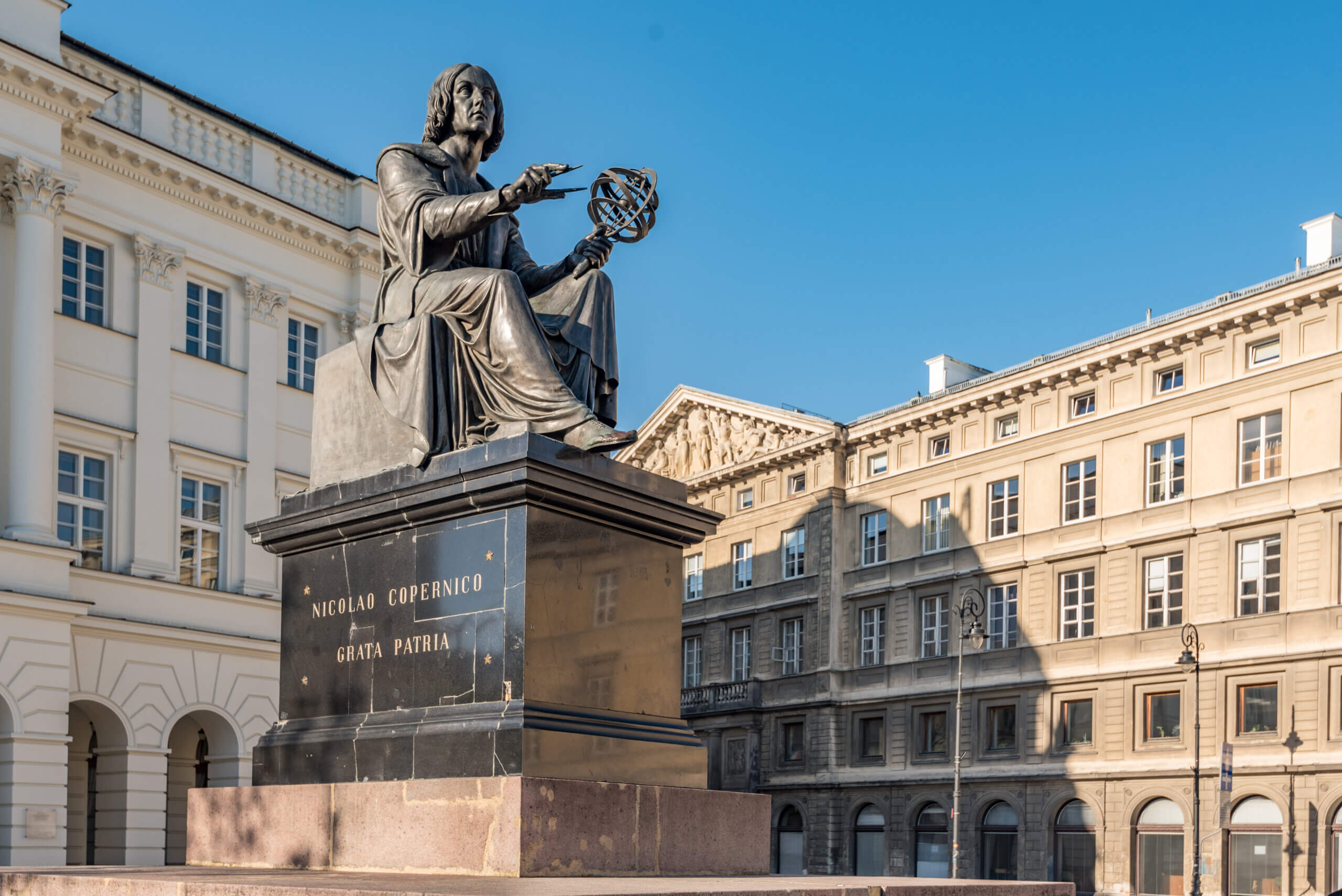Above: Nicolaus Copernicus Monument in Warsaw.
This past Sunday marked the 550th anniversary of birth in Toruń, a city in north-central Poland, on February 19, 1473, of “a timid, conservative cleric, who started the revolution against his will”: Nicolaus Copernicus.[1]
A student at the universities of Krakow (1491), Bologna (1496) and Padua (1501), an employee of the Papal Chancery in Rome (1500), our mathematician and canon (he received the minor orders) obtained a doctorate in canon law in Ferrara in 1503. He died on May 24, 1543 in Frombork, northern Poland, and only shortly before his death De revolutionibus orbium cœlestium (On the revolutions of the celestial spheres), his fundamental work, was published in Nürnberg with a dedication to Pope Paul III († 1549).
Let’s recall a letter of Pope Paul VI, according to which Copernicus,
a son of the Catholic Church, noted for the abundance and vastness of his knowledge […], besides being well versed in many disciplines, such as law, medicine and geography, he distinguished himself notably by detecting through his study the system or formation of the world which is commonly termed heliocentric. This theory, which was later completed and more accurately established by John Kepler, Galileo Galilei and Isaac Newton, is the basis of our conception of the cosmos. But […] he also stands out in Our mind as a religious man, for he joined faith and science in a marvelous fruitful relationship.[2]
To the founder of the modern astronomy is dedicated the Second Symphony Kopernikowska (Copernican), Op. 31, for soprano e baritono soloists, mixed choir and large orchestra, which the Polish composer Henryk Mikolaj Górecki († 2010) wrote in 1972, commissioned by the Kosciuszko Foundation in New York to commemorate the 500th anniversary of Copernicus’ birth.
Together with the more famous Krzysztof Penderecki († 2020) and Witold Lutosławski († 1994), Gorecki belongs to the prestigious Polish school of composition and is capable of combining old and new.
The colossal score of Copernican Symphony — Gorecki’s greatest work — is divided into two movements, for 36 minutes of music: the first movement, which imagines the chaos, is exclusively instrumental; the second, which represents the cosmos, uses the solo voices and the choir. To say it better:
the fortissimo dynamic, long silent pauses and rapid, chromatic motifs of the first movement are counterbalanced by a comparatively calm second movement […]. The thunderous cosmic vision of the mostly orchestral first movement is answered by a second movement whose proportions are considerably expanded in order to release the earlier tensions.[3]
In the strongly rhythmic first movement we find two contrasting ideas: in the former, violent percussion accents introduce a large six-octave chord distributed among the different instruments of the orchestra, repeated with small changes; in the latter, the trombones, the horns and the trumpets and then all the brasses make a kind of muffled noise, which repeats itself incessantly and widens.
“The second movement marks an important stage in Górecki’s conversion to a more consonant language since the late 1960s, a process which was clarified in several choral pieces and the Third Symphony.”[4]
In this intensely lyrical part of the Symphony, the strings play a more consonant and more static harmony, which accompanies the melody of the voices. The latter sing the Latin text of three psalmic fragments and some of Copernicus’ words: Deus, qui fecit cælum et terram (Ps 146:6), qui fecit luminaria magna, solem in potestatem diei, lunam et stellas in potentatem noctis (Sal 136:7-9). Quid autem cælo pulchrius, nempe quod continet pulchra omnia? (De revolutionibus orbium cœlestium, liber I) Domine, exaudi me in tua iustitia (Ps 143:1).
That is: God, the maker of heaven and heart, who made the great lights, the sun to rule the day, the moon and stars to rule the night. What, indeed, is more beautiful than heaven, which truly contains all beautiful things Lord, answer me in your righteousness.
In receiving, on February 28, 1995, an honorary doctorate from the Catholic University of America in Washington, D.C., Gorecki made his own the words his beloved compatriot Pope John Paul II had addressed to artists ten years earlier in Brussels:
Each authentic work of art interprets the reality beyond sensory perception. It is born of silence, admiration, or the protest of an honest heart. It tries to bring closer the mystery of reality. So what constitutes the essence of art is found deep within each person. It is there where the aspiration to give meaning to one’s life is accompanied by the fleeting sense of beauty and the mysterious unison of all things. Authentic and humble artists are perfectly well aware, no matter what kind of beauty characterizes their handwork, that their paintings, sculptures or creations are nothing else but the reflection of God’s Beauty. No matter how strong the charm of their music and words, they know that their works are only a distant echo of God’s Word.[5]
Perhaps it is precisely for this reason that Gorecki appears enjoyable even to the least informed listener: the awareness for an artist of singing “only a distant echo of God’s Word.”
[1] A. Koestler, The Sleepwalkers, New York 1959, p. 113.
[2] Paul VI, Letter to Cardinal Stefano Wyszyński on the 5th centenary of the birth of Niccolò Copernico, January 23, 1973. Our translation.
[3] A. Thomas, in The New Grove Dictionary of Music and Musicians, vol. 10, London 2001, p. 160.
[4] A. Thomas, ibidem.
[5] John Paul II, Homily, May 20, 1985, as translated in A. Thomas, Gorecki, Clarendon Press, 1997, p. 107.


